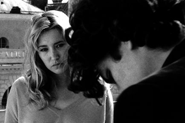Philippe Garrel’s atmospheric and luminous, if oddly cold and alienated The Frontier of Dawn represents an amalgam of the filmmaker’s familiar themes: the haunting of a failed love affair, the helplessness of seeing a loved one self-destruct, the guilt (and isolation) of survival, the fear of fleeting happiness. In this respect, the film’s crepuscular title represents a young photographer, François’s (Louis Garrel) anxiety in the days before his marriage to pretty, well-to-do Ève (Clémentine Poidatz) and impending fatherhood – a reluctance to lead a life of resigned “bourgeois happiness” that a friend once suggested after having lead a carefree – and largely bohemian – existence. Having once embarked on a passionate, if volatile relationship with a well known, highly strung actress named Carole (Laura Smet) only to devolve into uncertainty, disenchantment, callousness, and ultimately, abandonment when she continues to spend time with her estranged husband (and hides their affair from him) despite swooning, mutual declarations of love, François seems ready to move on from the ghosts of the past, until one day when he is tormented by the sight of Carole’s apparition in a mirror and is compelled to face their unreconciled destiny. Departing from the cultural specificity of his previous film, Regular Lovers, Garrel instead returns to the stark, hermetic environments of his earlier films – barren apartments and tightly framed interior spaces (particularly beds and dining tables), where even outdoor scenes are often devoid of other people) that reflect interiority. However, while the chamber framework serves to reinforce the visceral directness of earlier works such as Savage Innocence and I Can No Longer Hear the Guitar, the singularity in The Frontier of Dawn instead creates a detached, fabular atmosphere (a sense of otherworldliness that is also suggested by François’s dream involving a house in the forest) that detracts from the implicit emotional intensity given the story’s autofictional premise, resulting instead in a film with quintessential Garrelian elements that, like the film’s alterego, seems content with sleepwalking through familiar haunts and gestures.
© Acquarello 2009. All rights reserved.
